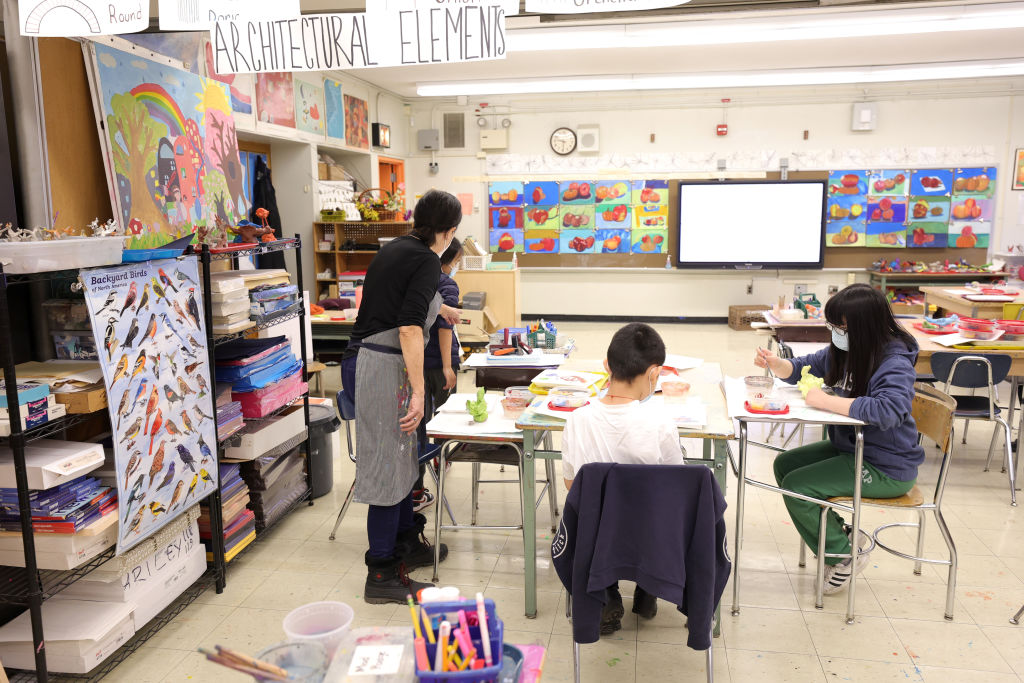Thousands of American Workers Are Being Forced to Work With COVID
With new CDC guidelines and apparent indifference from the White House, scores of workers in the United States find themselves with no choice but to go back to work while still suffering from COVID.

An art teacher at Yung Wing School PS 124 with students in her classroom on January 5, 2022 in New York City. (Michael Loccisano / Getty Images)
Lately, I’m hearing from a lot of people who are frustrated about how working in-person with COVID has become the norm at their job.
Right now, that dilemma is most visible among educators. As Business Insider reported, New York City teachers received an email from the Department of Education that said they can teach in-person five days after testing positive for COVID, even if they have some symptoms. Here’s Insider:
For teachers who test positive, symptoms that would allow them to return include a “minimal cough” — they can’t be “coughing up phlegm” — and symptoms have to be mild or improving. Teachers will have to distance themselves if they take off their “well-fitting higher-level face covering” to eat or drink. They also must “continue to stay at home outside of work” and “observe” other elements of isolation until 10 days pass.
This snippet was widely shared on social media, with people rightfully outraged at the nonsensical nature of the directive. Teachers must isolate everywhere except around children? The parsing of types of coughs as determining one’s fitness to work? But the truth is, this is happening in workplaces all across the country right now.
The updated CDC guidelines say that a person can return to work five days after testing positive for COVID, so long as they don’t have symptoms, as well as that those who are vaccinated and boosted do not need to quarantine after a COVID exposure. The result is a shortening of employers’ paid leave policies where they exist, and an across-the-board push to get people back in the workplace, even if their jobs put them in close contact with the most vulnerable of populations. The problem is worst at the lowest end of the wage spectrum, where paid-sick leave is a rarity.
Health care workers are in a particular quandary. National Nurses United (NNU) condemned the new CDC guidelines. “Weakening Covid-19 guidance now, in the face of what could be the most devastating Covid-19 surge yet, will only result in further transmission, illness, and death,” wrote NNU president Zenei Triunfo-Cortez in a letter to CDC director Rochelle Walensky.
As one health care worker tells me, staff and patients are taking turns giving each other COVID at their hospital, with patients catching COVID inside the facility. Doctors, for their part, are subject to the same pressure to return to work. There simply isn’t enough staff for health care facilities to function if those who remain stay home until they are no longer sick.
Why is that? Mostly, it’s because health care workers have quit in droves after being underpaid and overworked throughout the pandemic — this was already a problem before the COVID-19 pandemic, but it has been massively exacerbated over the past two years. Around one in five health care workers have left the field entirely in this period, and more continue to leave. It’s a vicious cycle: even with the explosion of the traveler or contract health care workforce, where nurses or respiratory therapists move from one understaffed facility to another, making far higher wages than those locations’ permanent staff, there simply aren’t enough people on the proverbial shop floor. Those permanent workers who remain are doubled and tripled up, no longer able to provide the care patients need. As one ICU nurse who recently quit his job put it, “I was actively helping kill people.”
For all the talk of how to contain the virus, without higher wages, stimulus checks, or guaranteed paid sick leave forthcoming, the implicit strategy is universal COVID exposure, including among particularly vulnerable populations.
If an employer says workers should report symptoms or a positive COVID test and mandates that they take five days off, but those days are unpaid, then many workers will choose not to report in the first place. One wants to protect one’s coworkers, or customers, or whoever else one may interact with while coming and going from work, but bills must be paid, and five days is 25 percent of a monthly income. Every person is on their own, and no state support is on the horizon. That is where we have landed.